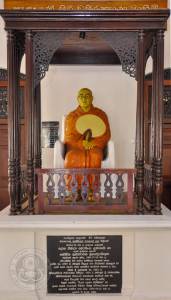සුගත් විනය නය මිණි පිරි විදුරු දෙණ – සුගත් දහම් රන් මහලට විදුරු හිණ
සුගත් නඳන නව මිණි වැලැ විදුරු මිණ – සුගත් පුතුනි මුළු ලෝ පළ විදුරු නැණ– මාතර, අමරසිරි ගුණවඩු මහ කිවියාණන්
Most Ven. Pelene Siri Vajiragnana Maha Nayaka Thero

It was the 1880s. Buddhists in Bambalapitiya formed a society by the name of ‘Dharma Samagama’. They built a ‘Dharma salawa’(preaching hall). In 1901 they invited Venerable Pelene Vajranana Thera who was then at Suvisuddharamaya in Wellawatta to come and reside in the hall they had built. Soon the place prospered. Vajiraramaya was thus born, soon to become a well‐known centre of the Dhamma.
By then Bud
dhists were getting used to hearing Pelene Hamuduruwo’s sermons at the Maitri Hall in the premises of Mettaramaya, Bambalapitiya ‐ a preaching hall where sermons are held regularly to this day. Pelene Hamuduruwo had been introduced to a lawyer, Richard Pereira who organised sermons there every Sunday. He selected Pelene Hamuduruwo, who w
as developing a style of his own, as the preacher. It was his pleasing style that made people listen.
Having been ordained in 1893 (he was 15 years then) under the tutelage of of Veragampitiye Siri Revata Maha Thera at the Dewagiri Vihara, Kamburupitiya, Pele Hamuduruwo learnt the Dhamma fast. In fact, his father’s decision to ordain the son was because of his deep interest in the Dhamma. The father, Muhandiram Don Andiris Tudawe Pandita Gunawardena was himself a scholar. Popularly known as ‘Tudawe Pandiththuma’ (Pandit Tudawe) he had been in robes for some time. His house was a haven of learning where Buddhists monks from all sects gathered to learn from him. His third son who was later to become Vajiranana Thera was an ardent listener. It did not take much time for the father to see where the son’s future lay.
Pelene Vajiragnana Hamuduruwo was quite fluent in the Dhamma by the time he entered the Vidyodaya Pirivena in 1897 for higher studies. That was the time Vidyodaya Pirivena (founded in 1873) flourished as the foremost seat of Buddhist learning under Venerable Hikkaduwe Sri Sumangala Nayaka Thera (1827‐1911).
It did not take much time for others to see Pelenen Hamuduruwo’s erudition and devotion. He was appointed Anu Nayaka of the Amarapura Dharmarakshita Nikaya in 1917 and a year later he became Maha Nayaka of the Nikaya, which post he held till he passed away on 21 September 1955.

He had a deep concern for the younger generation and his mission was to mould the young to be useful citizens of the world. Having started a Dhamma school at Vajirarama on Sundays, he concentrated not only on teaching the young ones the Dhamma but also the correct way of living. It was through simple creations of prose and verse that he taught them. ‘Bauddha Lamaya’, the children’s journal he started in 1937 (it is still being published) soon became a collector’s item. Edited by one of his pupils, Pamburana Metteiya Thera, it was sold for two cents. The popular journal carried simple verses which the children memorized. The theme was basically on how to be good children. His articles and poems are still being repeated in the Bauddha Lamaya making it possible for the present day children to appreciate them.
He was a prolific writer. According to one of his most distinguished pupils, Venerable Madihe Pannasiha Maha Nayaka Thera, the collection of his articles on the Dhamma can fill at least 25 volumes of 300 pages each. A few volumes have been published. ‘Shadhantha Chintha’ (reflections on words and their meanings) and ‘Buddhanta Shatakaya’ (hundred verses in praise of the Buddha) are among them. He contributed a large number of articles and verses to newspapers and journals. H was a regular contributor to Sirisara, a journal started by novelist W A Silva. He wrote under the pen name ‘Yatalaba Kiviyara’. He was fearless in attacking corruption and other misdeeds in society.
By example, he taught the student monks how to conduct themselves. They were silent observers at Dhamma discussions whenever Pelene Hamuduruwo met scholars and influential personalities who came to see him at Vajirarama. Among regular visitors were Venerable Kalukondayawe Pannasekera Maha Nayaka Thera and other leading scholar monks, and lay scholars including Sir Baron Jayatilaka, Professor Gunapala Malalasekera and Kumartunga Munidasa. They always sought his advice whenever they had to handle a problem relating to the Dhamma or the Sinhala language.
One of his greatest contributions was the moulding of at least 20 student monks who became leading lights in the Buddhist arena. Starting with Narada Maha Thera (as his first pupil he succeeded Pelene Hamuduruwo as Viharadhipati of Vajirarama), the list included Kamburugamuwe Mahanama Maha Thera, Denipitiye Sumanasiri Maha Thera, Koggala Rohana Maha Thera, Piyadassi Nayaka Thera, Pamburana Metteiya Thera, Soma Thera, Kassapa Thera, Nanamoli Thera and Nanavira Thera who are no more. Among those who are actively involved in the propagation of the Dhamma and social welfare work are Madihe Maha Nayaka Thera, Ampitiye Rahula Maha Thera, Kheminda Thera (now confined to bed due to ill health), Walgama Sugathananda Thera and Naotunne Gunasiri Thera. His only surviving brother monk until recently, Talalle Devananada Maha Thera, head of Mettaramaya passed away last year.
The Vajirarama Katikavata (Ecclesiastical Code) he prepared in the 1930s laid down clearly the way of life to be followed by monks belonging to Vajirarama and its branch temples. The line of succession is clearly indicated in the Katikavata according to which the most senior surviving pupil succeeds as Viharadhipati and the next in line is the Viharadhikari.
Pelene Hamuduruwo will long be remembered as one who possessed the qualities of a perfect monk as declared by the Buddha. He was learned (vyakta), amenable (vinita), profound (visharada), erudite (bahusruta) and upholder of the Dhamma (dharmadara).
Journal written by: Mr. D C Ranatunga





















